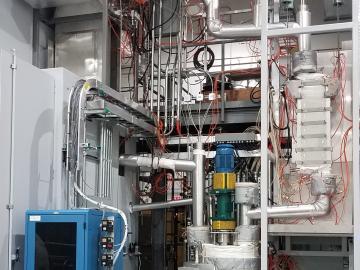
Filter News
Area of Research
- (-) Fusion and Fission (32)
- (-) Neutron Science (72)
- (-) Supercomputing (153)
- Advanced Manufacturing (5)
- Biological Systems (1)
- Biology and Environment (102)
- Biology and Soft Matter (4)
- Building Technologies (2)
- Chemical and Engineering Materials (3)
- Chemistry and Physics at Interfaces (7)
- Clean Energy (168)
- Climate and Environmental Systems (7)
- Computational Biology (1)
- Computational Chemistry (5)
- Computational Engineering (1)
- Computer Science (3)
- Data (1)
- Earth Sciences (1)
- Electricity and Smart Grid (1)
- Energy Frontier Research Centers (7)
- Fuel Cycle Science and Technology (2)
- Functional Materials for Energy (8)
- Fusion Energy (7)
- Geographic Information Science and Technology (1)
- Isotopes (21)
- Materials (122)
- Materials for Computing (13)
- Materials Synthesis from Atoms to Systems (8)
- Materials Under Extremes (7)
- National Security (45)
- Neutron Data Analysis and Visualization (2)
- Nuclear Science and Technology (27)
- Quantum Condensed Matter (3)
- Quantum information Science (4)
- Renewable Energy (2)
- Sensors and Controls (2)
- Transportation Systems (4)
News Type
News Topics
- 3-D Printing/Advanced Manufacturing (6)
- Advanced Reactors (2)
- Artificial Intelligence (22)
- Big Data (13)
- Bioenergy (6)
- Biology (6)
- Biomedical (10)
- Biotechnology (1)
- Buildings (3)
- Chemical Sciences (3)
- Clean Water (2)
- Climate Change (12)
- Composites (1)
- Computer Science (47)
- Coronavirus (7)
- Cybersecurity (2)
- Decarbonization (5)
- Energy Storage (4)
- Environment (17)
- Exascale Computing (13)
- Fossil Energy (1)
- Frontier (14)
- Fusion (12)
- Grid (2)
- High-Performance Computing (21)
- ITER (2)
- Machine Learning (9)
- Materials (9)
- Materials Science (13)
- Mathematics (1)
- Microscopy (2)
- Nanotechnology (6)
- National Security (3)
- Net Zero (2)
- Neutron Science (35)
- Nuclear Energy (20)
- Partnerships (1)
- Physics (5)
- Polymers (1)
- Quantum Computing (10)
- Quantum Science (10)
- Security (2)
- Simulation (12)
- Software (1)
- Space Exploration (2)
- Summit (21)
- Sustainable Energy (5)
- Transportation (5)
Media Contacts

Environmental scientists at ORNL have recently expanded collaborations with minority-serving institutions and historically Black colleges and universities across the nation to broaden the experiences and skills of student scientists while bringing fresh insights to the national lab’s missions.

Natural gas furnaces not only heat your home, they also produce a lot of pollution. Even modern high-efficiency condensing furnaces produce significant amounts of corrosive acidic condensation and unhealthy levels of nitrogen oxides

Scientists at ORNL have begun operating a unique system designed to enable a variety of testing to characterize the performance of an advanced heat transfer fluid for renewable energy

The truth is neutron scattering is not important, according to Steve Nagler. The knowledge gained from using it is what’s important

ORNL’s next major computing achievement could open a new universe of scientific possibilities accelerated by the primal forces at the heart of matter and energy.

Vivien Zapf has been named deputy director of the Quantum Science Center headquartered at ORNL. The QSC combines resources and expertise from national laboratories, universities and industry partners to accelerate the design and development of novel quantum technologies.

ORNL researchers are deploying their broad expertise in climate data and modeling to create science-based mitigation strategies for cities stressed by climate change as part of two U.S. Department of Energy Urban Integrated Field Laboratory projects.

Gang Seob “GS” Jung has known from the time he was in middle school that he was interested in science.

A new paper published in Nature Communications adds further evidence to the bradykinin storm theory of COVID-19’s viral pathogenesis — a theory that was posited two years ago by a team of researchers at the Department of Energy’s Oak Ridge National Laboratory.

Researchers in the geothermal energy industry are joining forces with fusion experts at ORNL to repurpose gyrotron technology, a tool used in fusion. Gyrotrons produce high-powered microwaves to heat up fusion plasmas.


